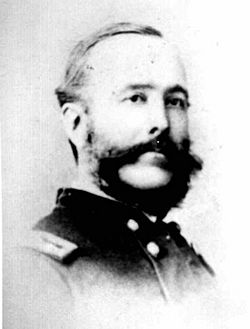William Gamble (general) facts for kids
Quick facts for kids
William Gamble
|
|
|---|---|
 |
|
| Born | 1 January 1818 Lisnarick, County Fermanagh, Ireland |
| Died | 20 December 1866 (aged 48) Virgin Bay, Nicaragua |
| Buried |
Virgin Grove Cemetery, Virgin Bay, Nicaragua
|
| Allegiance | |
| Service/ |
|
| Years of service | 1838–1843, 1861–1866 |
| Rank | |
| Commands held | 8th Illinois Cavalry |
| Battles/wars | Second Seminole War American Civil War |
| Signature | |
William Gamble (born January 1, 1818 – died December 20, 1866) was a smart engineer and a brave officer in the United States Army. He was a cavalry officer, meaning he led soldiers who rode horses. Gamble fought in the Second Seminole War and later for the Union during the American Civil War. He was a key leader at the famous Battle of Gettysburg.
Contents
Early Life and Start in the Army
William Gamble was born in a place called Duross, in Lisnarick, County Fermanagh, Ireland. He studied to become a civil engineer. This means he learned how to design and build things like roads and bridges. He even worked for the Queen's Surveying Office in Ireland.
In 1838, when he was 20, Gamble moved to the United States. He had experience as a "dragoon" (a type of soldier who rode horses) in the British army. So, he joined the U.S. Army as a private. He quickly moved up the ranks, becoming a sergeant major by 1839.
While in the army, he married Sophia Steingrandt in 1841. They had many children together. After fighting in the Seminole Wars, Gamble left the army in 1843. He then worked as a civil engineer in Chicago and lived in Evanston, Illinois.
William Gamble in the Civil War
When the American Civil War began, William Gamble joined the Union Army again. On September 18, 1861, he became a lieutenant colonel in the 8th Illinois Cavalry regiment. His friend, U.S. Congressman John F. Farnsworth, helped him get this position. Gamble's son, George, also joined the same regiment.
Early Battles and Injuries
Gamble's regiment was part of the Pennsylvania Reserve Division. They fought in the Peninsula Campaign. During this time, Gamble was wounded in the chest while leading a cavalry charge. He was injured more than a month after the main battles of the Seven Days Battles ended.
After he recovered, Gamble was promoted to colonel on December 5, 1862. This was just before the Battle of Fredericksburg. His regiment did not see much action in that battle. When his friend Farnsworth was promoted, Gamble took command of the 8th Illinois Cavalry.
In the spring of 1863, Gamble was promoted again. He was given command of the 1st Brigade in a cavalry division. However, he had to take medical leave during the Battle of Chancellorsville. He was suffering from health issues, possibly from his earlier wound or the cold winter.
Gamble at Gettysburg
During the Gettysburg Campaign, Gamble was still on leave and missed a big cavalry battle called Brandy Station. The officer who was temporarily leading his brigade was killed there. Gamble returned to duty on June 13, 1863.
His brigade was then assigned to Brigadier General John Buford's 1st Division. They arrived at Gettysburg on June 30. On the morning of July 1, they were riding at the front of the column. They were the first to spot soldiers from the Confederate Army of Northern Virginia. This is how the Battle of Gettysburg began.
Gamble's troops were greatly outnumbered by the Confederates. But they bravely fought and slowed down the enemy for about two hours. This gave the Union infantry, led by Major General John F. Reynolds, time to arrive and join the fight. When it was time to retreat, Gamble's troops moved to protect the infantry's left side. Gamble and Buford's cavalry played a very important role. They bought crucial time for the Union Army to get into position.
Later War Service
Later in 1863, Gamble commanded a cavalry division that protected Washington, D.C.. His soldiers also fought against a Confederate group led by John S. Mosby. Gamble was in charge of a horse training station called Camp Stoneman. However, his old wounds kept him from fighting on the battlefield anymore.
Gamble received a special promotion to brigadier general on December 12, 1864. He was fully promoted to brigadier general on September 25, 1865. He left the volunteer service on March 13, 1866. He then rejoined the regular army as a major in the 8th U.S. Cavalry.
After the War
William Gamble died from a serious illness called cholera on December 20, 1866. He was in Virgin Bay, Nicaragua, at the time. He was on his way to take command of the Presidio of San Francisco in California. He was buried in Virgin Grove Cemetery in Virgin Bay. However, that burial ground has since been covered by the waters of the bay.
In Popular Media
William Gamble has been shown in movies and books.
- In the 1993 film Gettysburg, actor Buck Taylor played him. This movie was based on the novel The Killer Angels.
- He also appears in the book Gettysburg: A Novel of the Civil War. In this story, he is taken as a prisoner of war.

